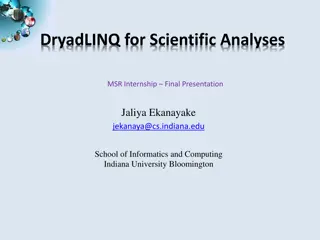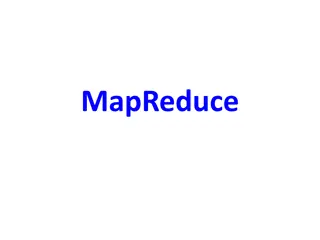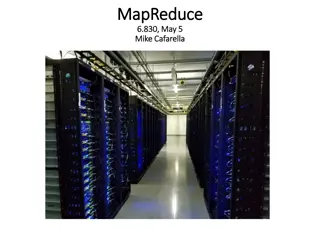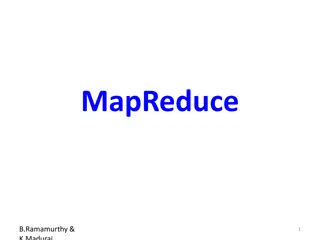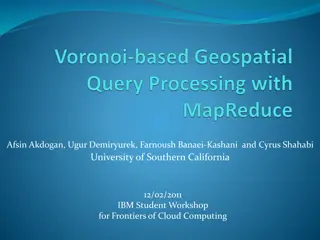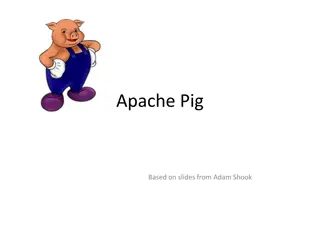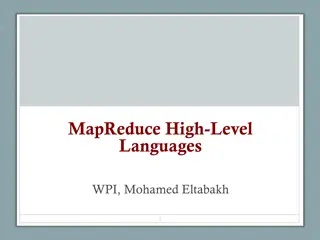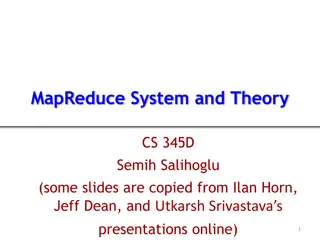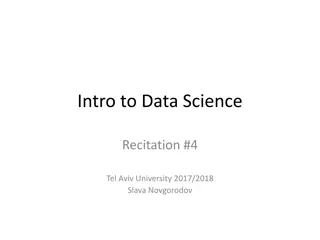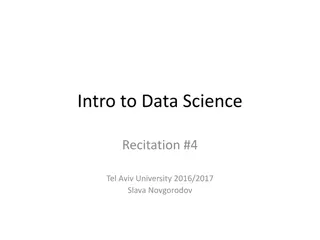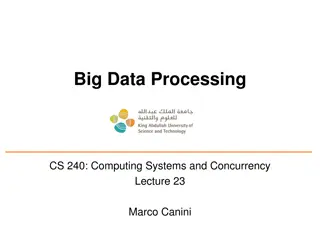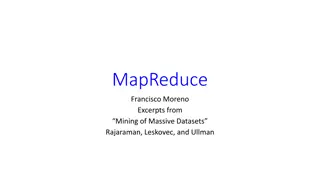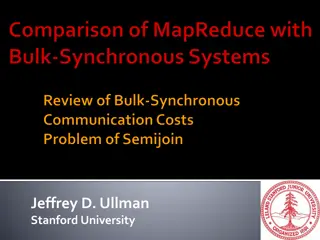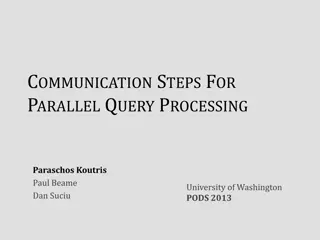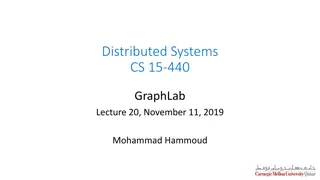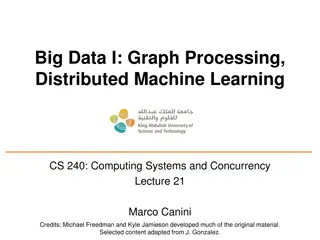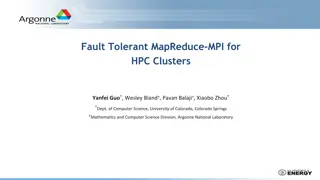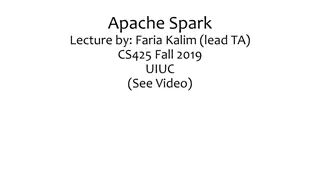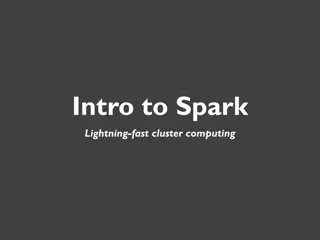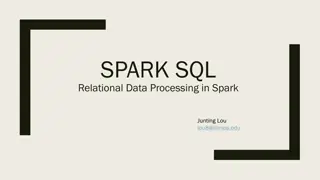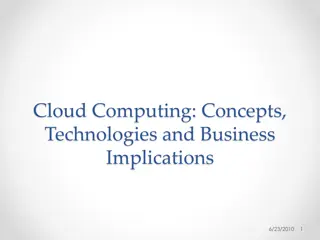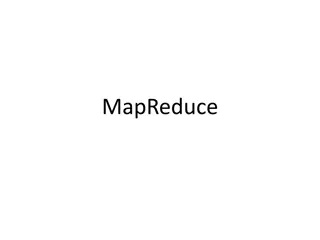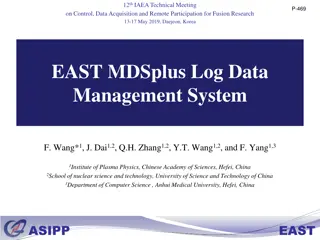Evaluation of DryadLINQ for Scientific Analyses
DryadLINQ was evaluated for scientific analyses in the context of developing and comparing various scientific applications with similar MapReduce implementations. The study aimed to assess the usability of DryadLINQ, create scientific applications utilizing it, and analyze their performance against
0 views • 20 slides
Understanding Apache Spark: Fast, Interactive, Cluster Computing
Apache Spark, developed by Matei Zaharia and team at UC Berkeley, aims to enhance cluster computing by supporting iterative algorithms, interactive data mining, and programmability through integration with Scala. The motivation behind Spark's Resilient Distributed Datasets (RDDs) is to efficiently r
0 views • 41 slides
Understanding MapReduce and Hadoop: Processing Big Data Efficiently
MapReduce is a powerful model for processing massive amounts of data in parallel through distributed systems like Apache Hadoop. This technology, popularized by Google, enables automatic parallelization and fault tolerance, allowing for efficient data processing at scale. Learn about the motivation
2 views • 33 slides
Understanding MapReduce for Large Data Processing
MapReduce is a system designed for distributed processing of large datasets, providing automatic parallelization, fault tolerance, and clean abstraction for programmers. It allows for easy writing of distributed programs with built-in reliability on large clusters. Despite its popularity in the late
0 views • 52 slides
Understanding MapReduce in Distributed Systems
MapReduce is a powerful paradigm that enables distributed processing of large datasets by dividing the workload among multiple machines. It tackles challenges such as scaling, fault tolerance, and parallel processing efficiently. Through a series of operations involving mappers and reducers, MapRedu
7 views • 32 slides
Cloud-based Geospatial Query Processing Using MapReduce and Voronoi Diagrams
This research paper presents a cloud-based approach for processing geospatial queries efficiently using MapReduce and Voronoi diagrams. The motivation behind the study, related works in the field, preliminary concepts of MapReduce, Voronoi diagram creation, query types, performance evaluation, and f
0 views • 30 slides
Introduction to Apache Pig: A High-level Overview
Apache Pig is a data flow language developed by Yahoo! and is a top-level Apache project that enables non-Java programmers to access and analyze data on a cluster. It interprets Pig Latin commands to generate MapReduce jobs, simplifying data summarization, reporting, and querying tasks. Pig operates
0 views • 57 slides
Understanding High-Level Languages in Hadoop Ecosystem
Explore MapReduce and Hadoop ecosystem through high-level languages like Java, Pig, and Hive. Learn about the levels of abstraction, Apache Pig for data analysis, and Pig Latin commands for interacting with Hadoop clusters in batch and interactive modes.
0 views • 27 slides
Understanding MapReduce System and Theory in CS 345D
Explore the fundamentals of MapReduce in this informative presentation that covers the history, challenges, and benefits of distributed systems like MapReduce/Hadoop, Pig, and Hive. Learn about the lower bounding communication cost model and how it optimizes algorithm for joins on MapReduce. Discove
0 views • 60 slides
Mathematical Modeling for Psychiatric Diagnosis in Big Data Environment
This research project led by Prof. Kazuo Ishii aims to develop a Big Data mining method and optimized algorithms for genomic Big Data, specifically targeting three major mental disorders including depression. The research process involves data analytics, mathematical modeling, and data processing te
0 views • 21 slides
Introduction to Map Reduce Paradigm in Data Science
Explore the MapReduce paradigm in data science through examples, discussions on when to use it, and implementation details. Understand how MapReduce is utilized for processing and generating big data sets efficiently.
0 views • 52 slides
Introduction to MapReduce Paradigm in Data Science
Today's lesson covered the MapReduce paradigm in data science, discussing its principles, use cases, and implementation. MapReduce is a programming model for processing big data sets in a parallel and distributed manner. The session included examples, such as WordCount, and highlighted when to use M
0 views • 48 slides
Data Processing and MapReduce: Concepts and Applications
Exploring concepts of big data processing, data-parallel computation, fault tolerance in MapReduce, generality vs. specialization in systems, and the efficiency of MapReduce for large computations such as web indexing. Understand the role of synchronization barriers, handling partial aggregation, an
0 views • 60 slides
Preliminary Steps in Setting Up a Hadoop Environment
Logging into the VM, changing passwords, transferring files to Hadoop, setting up Rstudio for MapReduce programming, and running the first MapReduce program are essential preliminary steps in establishing a Hadoop environment for data processing tasks.
0 views • 13 slides
Introduction to MapReduce: Efficient Data Processing Technique
Modern data-mining applications require managing immense amounts of data quickly, leveraging parallelism in computing clusters. MapReduce, a programming technique, enables efficient large-scale data calculations on computing clusters, reducing costs compared to special-purpose machines. MapReduce is
0 views • 72 slides
Introduction to Distributed Computing at Stanford University
A meeting at Stanford University's Gates building tonight for those interested in CS341 in the Spring. The session will cover the concept of viewing computation as a recursion on a graph, techniques like Pregel, Giraph, GraphX, and GraphLab for distributed computing, and challenges in data movement
0 views • 18 slides
MapReduce Method for Malware Detection in Parallel Systems
This paper presents a system call analysis method using MapReduce for malware detection at the IEEE 17th International Conference on Parallel and Distributed Systems. It discusses detecting malware behavior, evaluation techniques, categories of malware, and approaches like signature-based and behavi
0 views • 22 slides
Communication Steps for Parallel Query Processing: Insights from MPC Model
Revealing the intricacies of parallel query processing on big data, this content explores various computation models such as MapReduce, MUD, and MRC. It delves into the MPC model in detail, showcasing the tradeoffs between space exponent and computation rounds. The study uncovers lower bounds on spa
0 views • 25 slides
Introduction to GraphLab: Large-Scale Distributed Analytics Engine
GraphLab is a powerful distributed analytics engine designed for large-scale graph-parallel processing. It offers features like in-memory processing, automatic fault-tolerance, and flexibility in expressing graph algorithms. With characteristics such as high scalability and asynchronous processing,
0 views • 26 slides
Distributed Machine Learning and Graph Processing Overview
Big Data encompasses vast amounts of data from sources like Flickr, Facebook, and YouTube, requiring efficient processing systems. This lecture explores the shift towards using high-level parallel abstractions, such as MapReduce and Hadoop, to design and implement Big Learning systems. Data-parallel
0 views • 61 slides
Fault-Tolerant MapReduce-MPI for HPC Clusters: Enhancing Fault Tolerance in High-Performance Computing
This research discusses the design and implementation of FT-MRMPI for HPC clusters, focusing on fault tolerance and reliability in MapReduce applications. It addresses challenges, presents the fault tolerance model, and highlights the differences in fault tolerance between MapReduce and MPI. The stu
1 views • 25 slides
Introduction to Apache Spark: Simplifying Big Data Analytics
Explore the advantages of Apache Spark over traditional systems like MapReduce for big data analytics. Learn about Resilient Distributed Datasets (RDDs), fault tolerance, and efficient data processing on commodity clusters through coarse-grained transformations. Discover how Spark simplifies batch p
0 views • 17 slides
Introduction to Spark: Lightning-fast Cluster Computing
Apache Spark is a fast and general-purpose cluster computing system that provides high-level APIs in Java, Scala, and Python. It supports a rich set of higher-level tools like Spark SQL for structured data processing and MLlib for machine learning. Spark was developed at UC Berkeley AMPLab in 2009 a
0 views • 100 slides
Overview of Spark SQL: A Revolutionary Approach to Relational Data Processing
Spark SQL revolutionized relational data processing by tightly integrating relational and procedural paradigms through its declarative DataFrame API. It introduced the Catalyst optimizer, making it easier to add data sources and optimization rules. Previous attempts with MapReduce, Pig, Hive, and Dr
0 views • 29 slides
Overview of Cloud Computing Technologies and Business Implications
Explore the concepts, technologies, and business implications of cloud computing through a discussion on multi-core processors, virtualization, cloud service models (IaaS, PaaS, SaaS), data processing models like MapReduce, and real-world case studies. Learn about the evolution of internet computing
0 views • 18 slides
Understanding MapReduce: A Real-World Analogy
MapReduce is a programming model used to process and generate large data sets with parallel and distributed algorithms. In this analogy, the process of depositing, categorizing, and counting coins using a machine illustrates how MapReduce works, where mappers categorize coins and reducers count them
0 views • 43 slides
Development of Log Data Management System for Monitoring Fusion Research Operations
This project focuses on creating a Log Data Management System for monitoring operations related to MDSplus database in fusion research. The system architecture is built on Big Data Technology, incorporating components such as Flume, HDFS, Mapreduce, Kafka, and Spark Streaming. Real-time and offline
0 views • 6 slides
